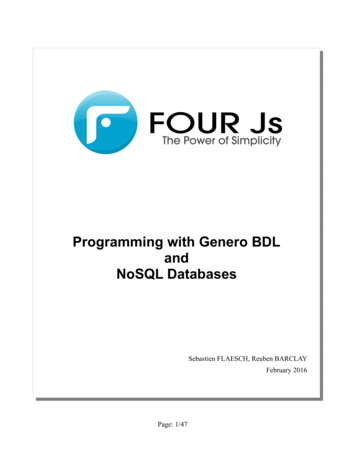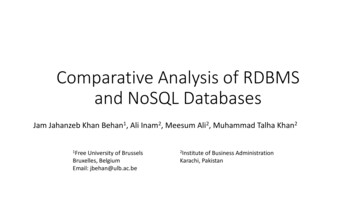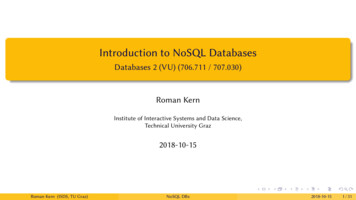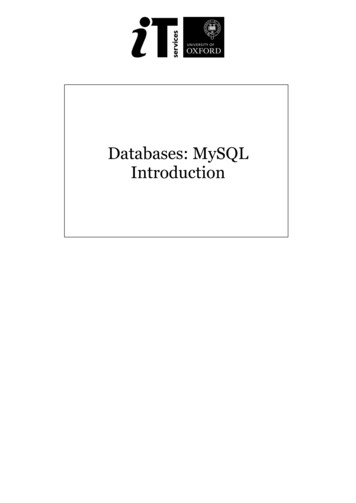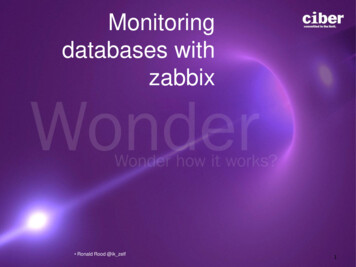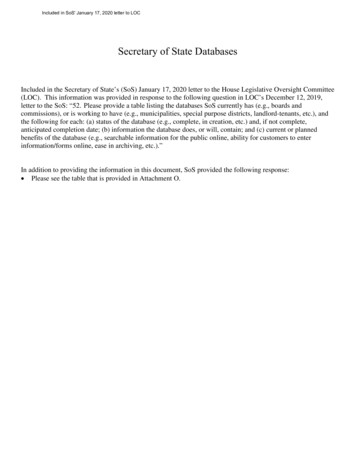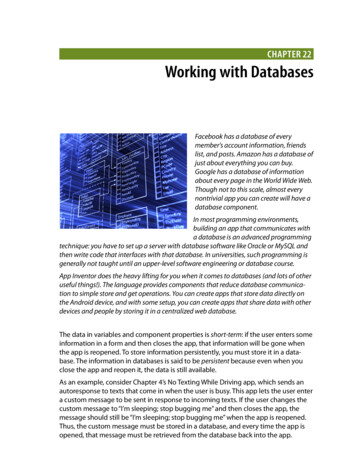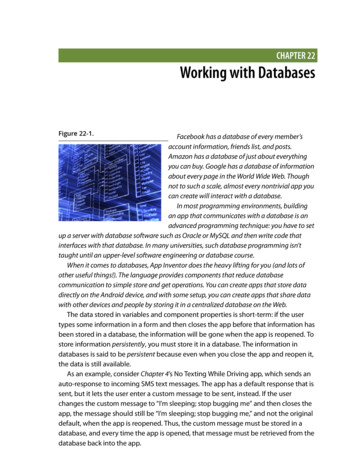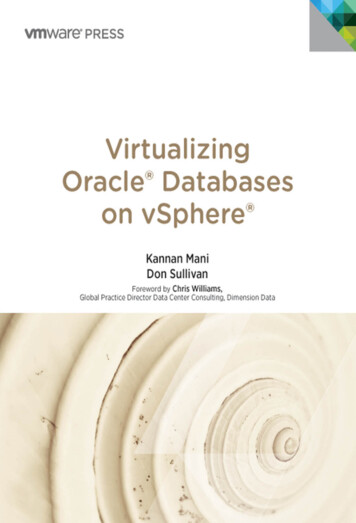
Transcription
CHAPTER22Object-Based DatabasesPractice Exercises22.1A car-rental company maintains a database for all vehicles in its current fleet. For all vehicles, it includes the vehicle identification number,license number, manufacturer, model, date of purchase, and color. Special data are included for certain types of vehicles: Trucks: cargo capacity.Sports cars: horsepower, renter age requirement.Vans: number of passengers.Off-road vehicles: ground clearance, drivetrain (four- or two-wheeldrive).Construct an SQL schema definition for this database. Use inheritancewhere appropriate.Answer: For this problem, we use table inheritance. We assume thatMyDate, Color and DriveTrainType are pre-defined types.create type Vehicle(vehicle id integer,license number char(15),manufacturer char(30),model char(30),purchase date MyDate,color Color)create table vehicle of type Vehiclecreate table truck(cargo capacity integer)under vehiclecreate table sportsCar1
2Chapter 22 Object-Based Databases(horsepower integerrenter age requirement integer)under vehiclecreate table van(num passengers integer)under vehiclecreate table offRoadVehicle(ground clearance realdriveTrain DriveTrainType)under vehicle22.2Consider a database schema with a relation Emp whose attributes areas shown below, with types specified for multivalued attributes.Emp (ename, ChildrenSet multiset(Children), SkillSet multiset(Skills))Children (name, birthday)Skills (type, ExamSet setof(Exams))Exams (year, city)a.Define the above schema in SQL, with appropriate types for eachattribute.b.Using the above schema, write the following queries in SQL.i. Find the names of all employees who have a child born on orafter January 1, 2000.ii. Find those employees who took an examination for the skilltype “typing” in the city “Dayton”.iii. List all skill types in the relation Emp.Answer:a.No Answer.b.Queries in SQL.i.Program:select enamefrom emp as e, e.ChildrenSet as cwhere ’March’ in(select birthday.monthfrom c)ii.Program:
Practice Exercises3select e.enamefrom emp as e, e.SkillSet as s, s.ExamSet as xwhere s.type ’typing’ and x.city ’Dayton’iii.Program:select distinct s.typefrom emp as e, e.SkillSet as s22.3Consider the E-R diagram in Figure 22.5, which contains composite,multivalued, and derived attributes.a.Give an SQL schema definition corresponding to the E-R diagram.b.Give constructors for each of the structured types defined above.Answer:a.The corresponding SQL:1999 schema definition is given below.Note that the derived attribute age has been translated into amethod.create type Name(first name varchar(15),middle initial char,last name varchar(15))create type Street(street name varchar(15),street number varchar(4),apartment number varchar(7))create type Address(street Street,city varchar(15),state varchar(15),zip code char(6))create table customer(name Name,customer id varchar(10),address Adress,phones char(7) array[10],dob date)method integer age()b.create function Name (f varchar(15), m char, l varchar(15))returns Namebeginset first name f;set middle initial m;set last name l;endcreate function Street (sname varchar(15), sno varchar(4), ano varchar(7))
4Chapter 22 Object-Based Databasesreturns Streetbeginset street name sname;set street number sno;set apartment number ano;endcreate function Address (s Street, c varchar(15), sta varchar(15), zip varchar(6))returns Addressbeginset street s;set city c;set state sta;set zip code zip;end22.4Consider the relational schema shown in Figure 22.6.a.Give a schema definition in SQLcorresponding to the relationalschema, but using references to express foreign-key relationships.b.Write each of the queries given in Exercise 6.13 on the aboveschema, using SQL.Answer:a.The schema definition is given below. Note that backward references can be addedbut they are not so important as in OODBSbecause queries can be written in SQL and joins can take care ofintegrity constraints.create type Employee(person name varchar(30),street varchar(15),city varchar(15))create type Company(company name varchar(15),(city varchar(15))create table employee of Employeecreate table company of Companycreate type Works(person ref(Employee) scope employee,comp ref(Company) scope company,salary int)create table works of Workscreate type Manages(person ref(Employee) scope employee,(manager ref(Employee) scope employee)create table manages of Managesb. i.select comp name
Practice Exercises5from worksgroup by comphaving count(person) all(select count(person)from worksgroup by comp)22.5ii.select comp namefrom worksgroup by comphaving sum(salary) all(select sum(salary)from worksgroup by comp)iii.select comp namefrom worksgroup by comphaving avg(salary) (select avg(salary)from workswhere comp company name "First Bank Corporation")Suppose that you have been hired as a consultant to choose a databasesystem for your client’s application. For each of the following applications, state what type of database system (relational, persistent programming language –based OODB, object relational; do not specify acommercial product) you would recommend. Justify your recommendation.a.A computer-aided design system for a manufacturer of airplanes.b.A system to track contributions made to candidates for publicoffice.c.An information system to support the making of movies.Answer:a.A computer-aided design system for a manufacturer of airplanes:An OODB system would be suitable for this. That is because CADrequires complex data types, and being computation oriented,CAD tools are typically used in a programming language environment needing to access the database.b.A system to track contributions made to candidates for publicoffice:A relational system would be apt for this, as data types are expected to be simple, and a powerful querying mechanism is essential.c.An information system to support the making of movies:Here there will be extensive use of multimedia and other complexdata types. But queries are probably simple, and thus an objectrelational system is suitable.
6Chapter 22 Object-Based Databases22.6How does the concept of an object in the object-oriented model differfrom the concept of an entity in the entity-relationship model?Answer: An entity is simply a collection of variables or data items.An object is an encapsulation of data as well as the methods (code) tooperate on the data. The data members of an object are directly visibleonly to its methods. The outside world can gain access to the object’sdata only by passing pre-defined messages to it, and these messagesare implemented by the methods.
22.1 A car-rental company maintains a database for all vehicles in its cur-rent fleet. For all vehicles, it includes the vehicle identification number, license number, manufacturer, model, date of purchase, and color. Spe- cial data are included for certain types of vehicles: Trucks: cargo capacity. Sports cars: horsepower, renter age requirement. Vans: number of passengers .
